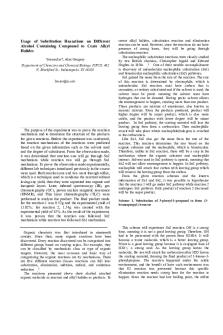Group Project JOC Note PDF

| Title | Group Project JOC Note |
|---|---|
| Course | Organic Chemistry Laboratory I |
| Institution | Indiana University - Purdue University Indianapolis |
| Pages | 4 |
| File Size | 181.8 KB |
| File Type | |
| Total Downloads | 85 |
| Total Views | 171 |
Summary
Chem lab group project...
Description
Substitution of Alcohol-Containing Compounds with Hydrogen Halides through Substitution Reactions Alexus Johnson, Mahussi Fagnon, Alejandra Palacio, and Opeibea Aidoo* Department of Chemistry and Chemical Biology, IUPUI, 402 N. Blackford St., Indianapolis, IN 46202 [email protected] Received April 23, 2018
contains the leaving group. The nucleophile attacks the electrophile causing the leaving group to leave. The new group then attaches to that abandoned carbon. Another important characteristic about these two reactions involves the activity of the electrophile, or the alkyl halide. In SN1 reactions, the halide is likely to attach to a tertiary carbon, due to carbocation stability. Carbocation stability occurs when the carbon is being substituted. Carbocation stability increases when substitution of the carbon increases. However, in an S N2 reaction, the halide attaches to a primary carbon, due to steric hindrance. Steric hindrance occurs when the nucleophile and electrophile collide instead of reacting with one another. Conceptually, the more groups surrounding the leaving group the slower the reaction happens. In this experiment, the three reactions carried out consisted of alcohols, with an –OH bond attached to a primary or secondary carbon. Since –OH was the leaving group in each reaction it was protonated into water, allowing the reaction to occur, because it was transformed into a good leaving group. The structure and placement of the alcohol contributes significantly to the reactions’ classification as an S N1 or SN2 reaction as well as explaining its’ products. Predicting the product given the starting material was simple after classifying the reaction. The product formed was tested by the experiment and the structure of the product was confirmed by analyzing the IR, GC, and 1H-NMR data. Scheme 1. Substitution of 3-phenyl-1-propanol to form 1bromo-3-phenylpropane.
The data and results of three substitution reactions containing hydrogen halides are reported. The method of substitution is considerably dependent on the properties and identity of the starting material containing alcohol. Whether the alcohol was primary, secondary, or tertiary determined the reactions’ mechanistic pathway. The resulting mechanistic pathways and an interpretation and justification of these substitutions for each of these reactions will be discussed further. The products formed were all tested via IR, GC, and 1H-NMR. Organic chemistry can be very specific and tedious in terms of its’ vast number of objectives. Understanding increases when organization is made priority in studying intricate material, as such. The classification of organic reactions is imperative to mastering the concepts of organic chemistry. Substitution is one of the four types of reactions and one of the most important. Substitution reactions occur when one sigma bound atom or group is replaced with another sigma bound atom or group. Substitution reactions are classified into two categories: SN1, unimolecular nucleophile substitution reaction, or SN2, bimolecular nucleophile substitution reaction. The difference between these two mechanisms is the ratedetermining step. SN1 reactions are first order meaning they occur step-by-step, or stepwise, and SN2 reactions are second order and occur in one step. In substitution reactions, the focus lies primarily on the nucleophile and electrophile, which
1
This reaction was classified as a SN2 substitution mechanism, based on its’ confirmed products. In this reaction, the achiral, –OH group of the starting material is attached to the primary carbon making the reaction easier and faster due to low steric hindrance. The primary carbon rarely goes through rearrangement, because the results are unfavorable and very unlikely to occur. This concerted mechanism requires the -OH leaving group to be replaced with a -Br halide from the reagent in excess, the NaBr. Only one product was observed, because the reaction was performed under acidic conditions making an elimination reaction less likely to occur. Heating via reflux was essential in overcoming activation energy. Therefore, extra precaution was taken during reflux in order to avoid burning or decomposition of the reagent due to the compounds’ high boiling points. However, burning was still observed as a red-brown liquid, which occupied the flask after reflux. After performing the reaction, 1H NMR, IR, and GC tests were performed to confirm the products’ identity and purity. The Infrared Spectroscopy data showed a fairly small peak around 3400cm-1, which indicated that a little OH or alcohol was left behind. However, a peak was present around 610cm-1, which indicates possible presence of the Br halide and aromatic substitution. Due to experimental error the 1H NMR could not be completed, therefore a predicted 1H NMR
was used to interpret how the data should be displayed. The data would have included 4 sets of equivalent hydrogen groups including two doublets and a triplet around 7.00ppm7.50ppm confirming aromatic substitution, a triplet and pentet around 2.10ppm-2.70ppm, and a triplet around 3.5ppm confirming the Br halide. The 1H NMR would not have displayed a singlet around 4.00ppm-5.00ppm, which indicates an alcohol functional group. The Thin Layer Chromatography data showed 3 shadow-like spots labeled a. Day 2 product, b. Day 3 product, and c. Starting Material, on the TLC plate. These first two spots listed traveled a much longer distance than the starting material, indicating the product, a much less polar molecule. Increasing and decreasing the amount of starting material and the temperature at which the reaction was ran, contributed to changes in percent yield of the reaction. Decrease in the amount of sulfuric acid added resulted in a low yield, due to the poor condition of the leaving group. Using more than 1 or 2 equivalents of NaBr did not provide a significant yield either. The product formed provided a 46.28%, which is still lower than expected and seemed to be impure as determined by the data gathered. This low yield may have resulted due to errors made during the lab, many regarding the reflux process. As mentioned above, the reactants were burned very quickly by the thermowells used in class, which are hard to manage and contribute to mechanical error most times. Another error of this experiment may have been the low amount of NaBr added which would directly decrease the percent yield, because it pushes the reaction to move toward products.
present around 2940-2965cm-1,which indicated the sp2 an sp3 hybridized carbons. Though not reported via the spectrophotometer, there is a peak present around 410cm -1, which indicates presence of the Br halide. Due to experimental error the 1H NMR could not be completed, therefore a predicted 1H NMR was used to interpret how the data should be displayed. The data would have included 5 sets of equivalent hydrogen groups including a sextet at 3.80ppm confirming the Br halide, a doublet and quartet at 1.71ppm, a sextet at 1.31ppm, and a triplet at 0.89ppm. The 1H NMR would not have displayed a singlet around 4.00-4.50.ppm, which indicates an alcohol functional group. Increasing and decreasing the amount of starting material and the temperature at which the reaction was ran, contributed to changes in percent yield of the reaction. Using more than 1 or 2 equivalents of NaBr did not provide a significant yield either. Excluding the sulfuric acid would yield no product or a very low percent yield. The product formed provided a 17.47%, which was very low and much lower than expected. The product had a very few impurities as determined by the GC data collected. This low yield may have resulted due to errors made during the lab which include again not adding enough NaBr, not adding enough sulfuric acid, and not letting the reaction reflux for long enough to ensure a complete reaction. Scheme 3. Substitution of 2,4-dimethyl-3-pentanol to form 3chloro-2,4-dimethylpentane and 2-chloro-2,4-dimethylpentane
Scheme 2. Substitution of 2-pentanol to form 2-bromopentane
For this reaction, the product had a low boiling point, so reflux was performed under extra precaution, beginning at a low temperature. Distillation was not performed for this reaction, because each trial yielded very little product. In this reaction, the -OH group of the starting material is attached to a secondary carbon, again making it a little faster, due to low steric hindrance. Secondary carbons that form a carbocation may go through rearrangement to form a carbocation that is more stable. Because of this, the reaction may undergo both SN1 or SN2 mechanisms. However, the analysis of IR, GC, and 1H NMR data confirmed the formation of only 1 product meaning that this reaction is classified as having an SN2 mechanism. The Gas Chromatography data displayed the pure product displaying only 2 peaks, the first being DCM and the second at 4.6 minutes, which was the product. Although a little too much DCM was used as indicated by the extremely high first peak, peak 2 had a 100% composition when calculated. The Infrared Spectroscopy data showed a fairly small hump around 3400cm -1, which indicated a little residual alcohol. However, this small hump was not reported as a peak and therefore irrelevant. A few peaks were
2
Observation of this scheme’s products and byproducts, classified this reaction as a SN1, a stepwise mechanism. In this reaction, the achiral, –OH group of the starting material is attached to a secondary carbon. The attack of the nucleophile, HCl, protonated the –OH, which resulted in water as the leaving grThis step caused the secondary carbon that formed a carbocation to undergo rearrangement in order to form a more stable carbocation. Due to carbocation stability, the hydride shift that occurred when Cl is moved to the most substituted carbon to form the major, more stable product, which further proves a SN1 mechanism. For this reaction reflux played a huge role in speeding up the rate of the reaction, since S N1 reactions are known to take quite sometime to complete. The analysis of IR, GC, and 1H NMR data confirmed this mechanism as well. The Gas Chromatography data displayed 100% purity of the product. The Infrared Spectroscopy data showed no peak around 3400cm -1-3600cm-1, indicating no presence of alcohol in the product. The data showed a peak at 2914 cm-1 and 2872cm-1, indicating presence of sp3 hybridized carbons. Though not reported via the spectrophotometer, there is a peak present around 400cm -1, which indicates presence of the Cl halide as well. To confirm this product, 1H NMR data was collected and interpreted. The data was a little unclear, due to mechanical difficulties, therefore a predicted 1H NMR was used to interpret how the data should be displayed. The
data would have included 4 sets of equivalent hydrogen groups including a doublet at 0.91ppm, a singlet at 1.59ppm, a doublet at 1.35ppm, and a multiplet at 1.62ppm, all confirming the structure of the major product. Increasing and decreasing the amount of starting material and the temperature at which the reaction was ran, contributed to changes in percent yield of the reaction. Using more than 1 or 2 equivalents of NaBr did not provide a significant yield either. Excluding the sulfuric acid would yield no product or a very low percent yield. The product formed provided a 32.80%, which was low. The product had a very few impurities as determined by some of the data gathered. This low yield may have resulted due to errors made during the lab which include evaporation of material if not covered properly in drawer, excessive or extended time of reflux led to a low percent yield as well. Experimental Section The primary and secondary alcohol substitution reaction that was conducted in this experiment was performed under standard conditions. 1H NMR was carried out using a Varian Gemini 200 MHz spectrometer. GC was performed using the GOW-MAC GC-400 TCD. IR was performed using salt plates on the Thermo-Nicolet 380 FT-IR. TLC data was performed using a polar silica gel plate containing DCM solvent. 1-bromo-3-phenylpropane (1). Reaction 1 was prepared by adding the alcohol starting material (3.0g, 0.0191 mol) and sodium bromide (2.71g, 0.0369 mol) to a 50 mL round bottom. Then, 9M sulfuric acid (5.0mL, 0.1069 mol) was added to the flask followed by the stir bar. The mixture was heated under
standard reflux conditions for about 30 minutes very carefully, due to its high boiling point. After reflux, the mixture was allowed to cool and then vacuum filtration was used to remove the excess liquid from the sodium bromide solid product. The reaction was transferred to a separatory funnel and the top and bottom layer were separated. The bottom red-colored, aqueous layer was disposed of and the organic layer was extracted. The extraction included washing with 2 separate 5-mL portions of 5% sodium bicarbonate. Sodium sulfate was then added to dry the product and separated using gravity filtration. Product 1 yielded a brownish liquid substance (2.03g, 0.0102 mol, 46.28%). 1-bromo-3-phenylpropane (1). 1H NMR, IR and TLC data was collected using the resulting product. 1H NMR (DMSO, 300 MHz) δ2.12 (p, 2H), 2.63 (t, 2H), 3.51 (t, 2H), 7.19 (t, 2H), 7.24 (t, 2H), 7.24 (d, 2H). IR (cm -1) ~3400, 3085, 3062, 3026, 2939, 289, 1603. TLC (DCM, cm) Rf value: starting material-0.24, day 2-0.88, day 3-0.88. 2-bromopentane (2). Reaction 2 was prepared by adding the alcohol starting material (4.01g, 0.0455 mol) and sodium bromide (7.00g, 7.73mL, 0.068 mol) to a 50 mL round bottom flask. Five milliliters of water was added to dissolve the sodium bromide before adding it to the alcohol starting material. A stir bar was added to the mixture. While stirring, 18.4M sulfuric acid (6.00mL, 0.1104 mol) was slowly added to the mixture. The reaction was heated under standard reflux conditions for about 50 minutes. After reflux, the mixture was allowed to cool and then transferred to a separatory funnel. The resulting reaction material was washed with 25 mL of
3
water. Aqueous layer was drained and the organic layer was left in the separatory funnel. Then the mixture was washed with 2 separate 15mL portions of 5% sodium bicarbonate. Lastly, sodium sulfate was used to remove any excess water that remained in the resulting product. Product 2 was a yellowish-clear, oil based liquid (1.2 g, 0.0079 mol, 17.47%). 2-bromopentane (2). 1H NMR, IR and GC data was collected using the resulting product. 1H NMR (DMSO, 300 MHz) δ3.80 (sext, 1H), 1.71 (q, 2H), 1.71 (d, 3H), 1.31 (sext, 2H), 0.89 (t, 3H). IR (cm -1) 2963, 2934, 2853, 1467, 1360, 1224, 1190, 1148. GC (TCD) 13.2 cm (100%). 3-chloro-2,4-dimethylpentane and 2-chloro-2,4dimethylpentane (3). Reaction 3 was prepared by adding the
alcohol starting material (3.38g, 0.035 mol) and zinc chloride, Lucas Reagent, (5.51g, 0.040 mol) to a 100 mL round bottom and heated under standard reflux conditions for 30 minutes. After reflux, the resulting mixture was transferred to a separatory funnel. The product was washed with 2 separate portions 10 mL of deionized water. Then the product was washed twice with 12 mL portions of 5% sodium bicarbonate. Lastly, sodium sulfate was used to dry the resulting product. The sodium sulfate was separated via gravitation. Product 3 yielded a clear liquid (1.43g, 0.011 mol, 32.80%). 2-chloro2,4-dimethylpentane (3, major product). 1H NMR, IR and GC data was collected using the resulting product. 1H NMR (CDCl3, 400 MHz) δ0.91 (d, 6H), 1.37 (d, 2H), 1.59 (s, 6H), 1.62 (m, 1H). IR (cm -1) 2914, 2872. GC (TCD) 15.5 cm (100%). Conclusion To conclude, hypotheses and observations of alcoholcontaining compounds producing substituted halogencontaining products 1, when reacted with hydrogen halides, were successfully confirmed. These products were created through observation and experimentation of the alcoholcontaining structure and its’ perceived mechanism. Each reaction yielded product, however impurities in the product, caused by errors, disrupted the results of each reaction. The yield for reaction 2 and 3 were a little on the lower side, 32.80% and 17.47%, respectively. A low percent yield may have resulted, because more than a few errors were made during each trial of these experiments. The percent yield for reaction 1 was a little higher at 46.28%, which is low but better when considering the number of errors made during each trial of the experiment. Things that can be changed to produce exceptional results include using little to no water at all in each rFeaction and enforcing the importance of quantitative transferring.
Acknowledgement. This work was made possible by the Department of Chemistry and Chemical Biology at IUPUI. References. 1. Denton, R.E.; Audu, C. “Investigating Substitution Reactions of Various Alcoholic Compounds.” Fake Journal of Organic Chemistry 2010, 77, 3452-3453.
2. Lehman, J. W. Operational Organic Chemistry: A Problem-Solving Approach to the Laboratory Course, 2nd ed.; Prentice Hall: Upper Saddle River, NJ, 2009. 3. James. “Comparing the SN1 and SN2 Reactions.” Master Organic Chemistry RSS. Date accessed: 21 April 2018.
4...
Similar Free PDFs
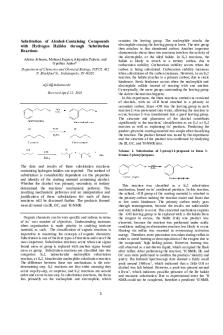
Group Project JOC Note
- 4 Pages

Example JOC Note
- 3 Pages

JOC BRUT. Resum - Joc brut
- 1 Pages
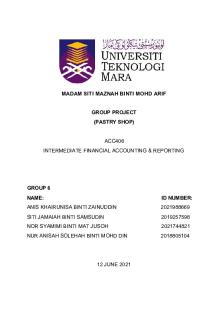
Group Project Account ( Group 6)
- 21 Pages
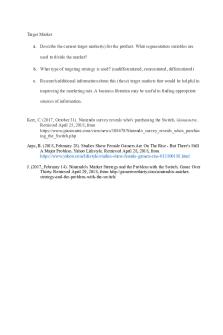
Group Project- Target Market
- 4 Pages
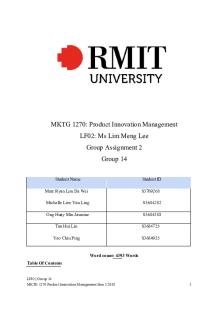
PIM Group Project 2
- 68 Pages
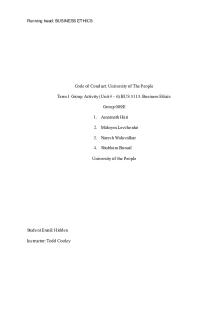
Group Project 009E Final
- 21 Pages

Group Project Proposal
- 1 Pages
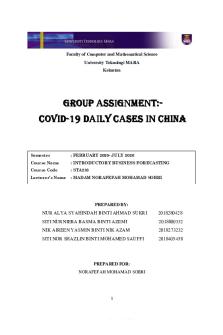
Group Project STA 233
- 33 Pages
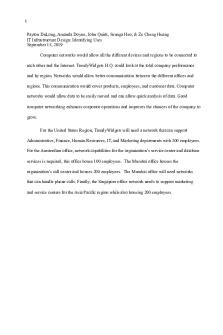
IST Group Project
- 19 Pages

Group project guidelines
- 1 Pages

group project sta108
- 55 Pages

CSR Group Project ASM401
- 18 Pages

MNT group Project
- 9 Pages

Victoria\'s Secret Group Project
- 11 Pages
Popular Institutions
- Tinajero National High School - Annex
- Politeknik Caltex Riau
- Yokohama City University
- SGT University
- University of Al-Qadisiyah
- Divine Word College of Vigan
- Techniek College Rotterdam
- Universidade de Santiago
- Universiti Teknologi MARA Cawangan Johor Kampus Pasir Gudang
- Poltekkes Kemenkes Yogyakarta
- Baguio City National High School
- Colegio san marcos
- preparatoria uno
- Centro de Bachillerato Tecnológico Industrial y de Servicios No. 107
- Dalian Maritime University
- Quang Trung Secondary School
- Colegio Tecnológico en Informática
- Corporación Regional de Educación Superior
- Grupo CEDVA
- Dar Al Uloom University
- Centro de Estudios Preuniversitarios de la Universidad Nacional de Ingeniería
- 上智大学
- Aakash International School, Nuna Majara
- San Felipe Neri Catholic School
- Kang Chiao International School - New Taipei City
- Misamis Occidental National High School
- Institución Educativa Escuela Normal Juan Ladrilleros
- Kolehiyo ng Pantukan
- Batanes State College
- Instituto Continental
- Sekolah Menengah Kejuruan Kesehatan Kaltara (Tarakan)
- Colegio de La Inmaculada Concepcion - Cebu
